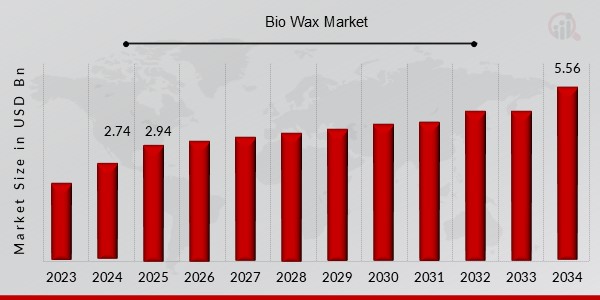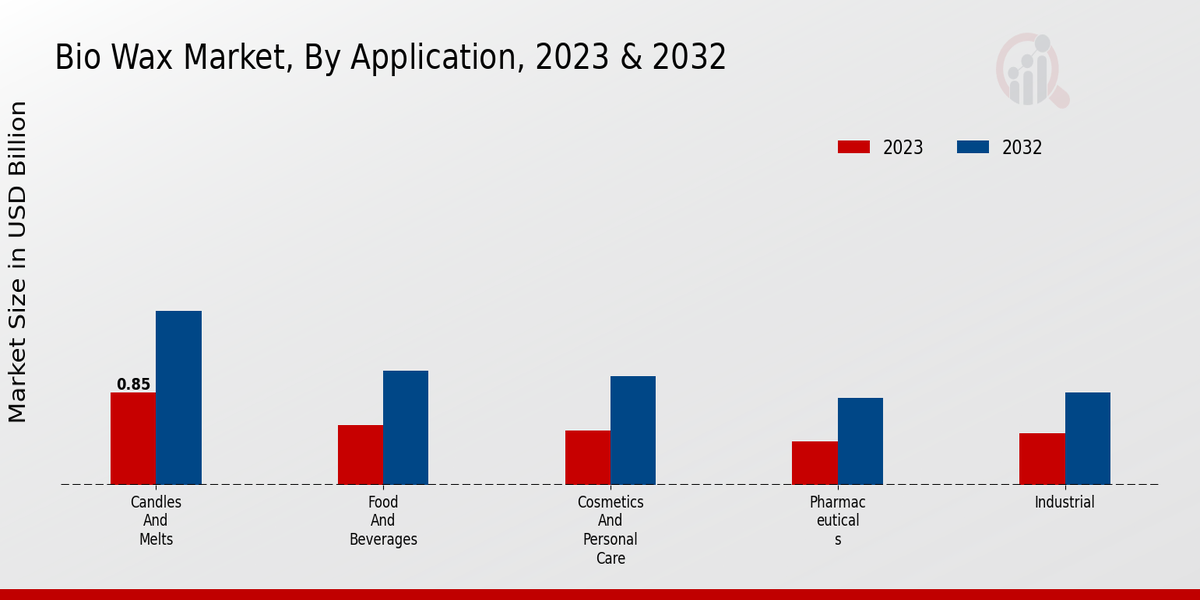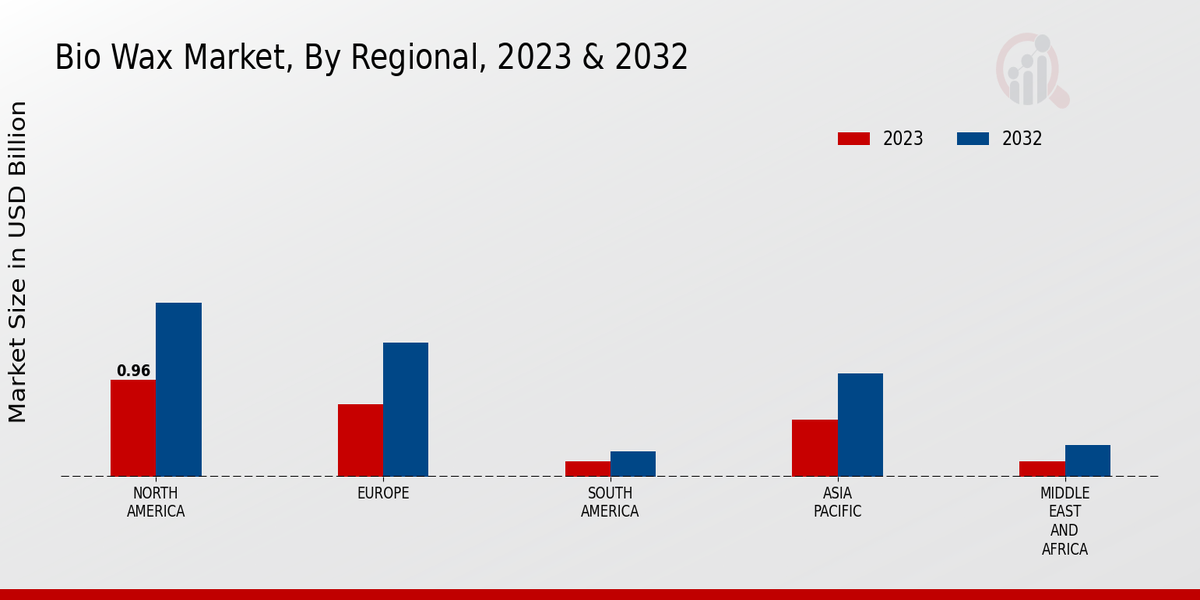Global Bio Wax Market Overview
The Bio Wax Market Size was estimated at 2.74 (USD Billion) in 2024. The Bio Wax Industry is expected to grow from2.94(USD Billion) in 2025 to 5.56(USD Billion) by 2034. The Bio Wax Market CAGR (growth rate) is expected to be around 7.3% during the forecast period (2025 - 2034).
Key Bio Wax Market Trends Highlighted
Essential market trends in the Bio Wax market include the rising demand for natural and sustainable products, growing awareness of environmental concerns, and technological advancements in production processes. Key market drivers are the increasing use of bio wax in candles, cosmetics, personal care products, and industrial applications.Opportunities for exploration and capture lie in the development of eco-friendly and biodegradable bio wax blends, the expansion of applications in emerging markets, and collaborations between manufacturers and end-users to address specific industry needs. Recent trends indicate a shift towards plant-based and renewable feedstocks, such as palm, soy, and sugarcane waxes, to meet the growing demand for sustainable and ethical products.

Source: Primary Research, Secondary Research, MRFR Database and Analyst Review
Bio Wax Market Drivers
Rising Demand for Natural and Sustainable Products
Consumers are increasingly seeking out natural and sustainable products, including those made with bio wax. Bio wax is a biodegradable and renewable resource that can be used to create a variety of products, such as candles, cosmetics, and food packaging. The growing demand for natural and sustainable products is a major driver of the Bio Wax Market Industry.
Increasing Applications in Personal Care and Cosmetics
Bio wax is a versatile ingredient that can be used in a variety of personal care and cosmetic products. It is often used as a thickening agent, emulsifier, and emollient. Bio wax can also be used to create natural fragrances and flavors. The increasing use of bio wax in personal care and cosmetic products is a major driver of the Bio Wax Market Industry.
Growing Awareness of Environmental Sustainability
Consumers are becoming increasingly aware of the environmental impact of their purchasing decisions. Bio wax is a sustainable and environmentally friendly alternative to traditional waxes. It is made from renewable resources and is biodegradable. The growing awareness of environmental sustainability is a major driver of the Bio Wax Market Industry.
Bio Wax Market Segment Insights
Bio Wax Market Application Insights
The Bio Wax Market is segmented into various applications, including candles and melts, food and beverages, cosmetics and personal care, pharmaceuticals, and industrial. Each application presents unique market dynamics and growth opportunities. Candles and melts constitute a significant segment of the Bio Wax Market, driven by the growing popularity of scented candles and wax melts for home fragrance and aromatherapy. Candles and melts offer a wide range of scents and designs, catering to diverse consumer preferences. The increasing demand for natural and sustainable products has further fueled the growth of bio wax candles and melts.Food and beverages is another key application segment for bio wax. Bio wax is used as a coating or glazing agent in various food products, such as fruits, vegetables, and confectionery items. It provides a protective layer that enhances the shelf life and appearance of food products. The growing demand for healthy and minimally processed food products is expected to drive the growth of bio wax in the food and beverage industry. Cosmetics and personal care is a promising segment for bio wax, owing to its emollient and moisturizing properties. Bio wax is used in a range of cosmetic products, including lipsticks, balms, and lotions.It provides a smooth and velvety texture to cosmetics, enhancing their application and feel on the skin. The increasing consumer awareness about the benefits of natural ingredients in personal care products is likely to support the growth of bio wax in this segment. Pharmaceuticals is another important application segment for bio wax. Bio wax is used as a carrier or base for various pharmaceutical formulations, such as ointments, creams, and suppositories. It provides a stable and inert matrix for drug delivery, ensuring effective absorption and release of active ingredients.The growing demand for bio-based and eco-friendly excipients in the pharmaceutical industry is expected to drive the growth of bio wax in this segment. Industrial applications of bio wax are also gaining traction. Bio wax is used as a lubricant, release agent, and polish in various industrial processes. It offers excellent release properties, reducing friction and wear in machinery and molds. The growth is attributed to the increasing demand for bio-based and sustainable materials across various industries, coupled with the expanding applications of bio wax in candles and melts, food and beverages, cosmetics and personal care, pharmaceuticals, and industrial sectors.

Source: Primary Research, Secondary Research, MRFR Database and Analyst Review
Bio Wax Market Source Insights
The source segment plays a crucial role in the Bio Wax Market segmentation, influencing market dynamics and growth prospects. Soybean, palm, coconut, rapeseed, and sunflower are the primary sources of bio wax, each with unique characteristics and market share. Soybean accounts for a significant portion of the Bio Wax Market revenue, driven by its wide availability and cost-effectiveness. Palm oil, derived from the palm tree, offers high yields and is a sustainable alternative to petroleum-based waxes, contributing to its growing market share.Coconut wax, known for its natural and eco-friendly properties, is gaining traction in personal care and cosmetic applications. Rapeseed and sunflower waxes, extracted from rapeseed and sunflower plants, respectively, are emerging sources with potential for growth in niche markets. Understanding the source segment dynamics is essential for market participants to align their strategies and capitalize on growth opportunities. By leveraging Bio Wax Market data and statistics, stakeholders can identify key trends, assess competitive landscapes, and make informed decisions to drive market growth and profitability.
Bio Wax Market Form Insights
The Bio Wax Market is segmented based on Form into Solid, Flakes, Powder, and Liquid. Among these, the Solid segment held the largest market share in 2023 and is projected to continue its dominance throughout the forecast period. The Solid form of bio wax is preferred due to its ease of handling, storage, and transportation. The Flakes segment is expected to register a significant CAGR during the forecast period, owing to its versatility and wide range of applications in various industries. The Powder segment is gaining traction due to its use in cosmetics and personal care products.The Liquid segment is anticipated to witness a steady growth rate, driven by its use in industrial applications.
Bio Wax Market End-Use Insights
The end-use segment is a crucial aspect of the Bio Wax Market segmentation, providing insights into the various applications of bio waxes across different industries. The residential sector holds a significant share of the market, driven by the increasing demand for eco-friendly and sustainable waxes for household applications such as candles, furniture polish, and floor care products. The commercial segment is also witnessing steady growth due to the rising adoption of bio waxes in hospitality, retail, and healthcare industries for cleaning, polishing, and protective coatings.Moreover, the industrial segment is projected to expand rapidly over the forecast period, fueled by the growing demand for bio waxes in automotive, packaging, and manufacturing industries as a sustainable and cost-effective alternative to traditional waxes.
Bio Wax Market Regional Insights
The regional segmentation of the Bio Wax Market offers insights into market dynamics across key geographic regions. In 2023, North America accounted for a significant share of the market, primarily driven by the presence of major manufacturers and increasing demand from industries such as packaging and cosmetics. Europe held the second-largest market share and is estimated to exhibit steady growth due to the growing awareness of eco-friendly solutions and regulations favoring sustainable packaging. The APAC region is expected to witness notable growth in the coming years, attributed to the rapid expansion of the packaging industry and rising demand from emerging economies like China and India.South America and MEA are expected to contribute a smaller share to the market, but with increasing urbanization and economic growth, these regions present potential growth opportunities for bio wax manufacturers.

Source: Primary Research, Secondary Research, MRFR Database and Analyst Review
Bio Wax Market Key Players And Competitive Insights
Major players in the Bio Wax Market industry are continuously focusing on Bio Wax Market development and innovation, which is expected to intensify the competitive landscape in the coming years. Leading Bio Wax Market players are adopting various strategies to gain a competitive edge in the market, including mergers, acquisitions, and collaborations. They are also investing heavily in research and development to create new and improved products. The Bio Wax Market Competitive Landscape is expected to remain highly competitive in the future, with new players entering the market and existing players expanding their product portfolios.One of the key competitors in the Bio Wax Market is Clariant, a leading specialty chemicals company headquartered in Switzerland. Clariant offers a wide range of bio-based products, including bio waxes, which are used in a variety of applications such as cosmetics, personal care, and industrial lubricants. Clariant's bio waxes are known for their high performance and sustainability, and the company has a strong focus on innovation and customer service.Another major competitor in the Bio Wax Market is Croda International Plc, a British company that specializes in the production of specialty chemicals for the personal care, cosmetics, and health care industries. Croda offers a range of bio-based products, including bio waxes, which are used in a variety of applications such as skin care, hair care, and makeup. Croda's bio waxes are known for their high quality and performance, and the company has a strong focus on sustainability and innovation.
Key Companies in the Bio Wax Market Include
- Ashland
- Afton Chemical
- Koster Keunen
- Evonik
- Innospec
- The Lubrizol Corporation
- Sonneborn
- Clariant
- AkzoNobel
- Chevron Phillips Chemical
- Michelman
- Baerlocher
- Strahl Pitsch
- Croda International
- Dow
Bio Wax Market Industry Developments
The bio wax market is projected to reach USD 4.5 billion by 2032, exhibiting a CAGR of 7.3% during the forecast period 2024-2032. Rising consumer awareness regarding the harmful effects of synthetic waxes, coupled with growing demand for natural and sustainable products, is driving market growth. Bio wax finds application in various industries including food, cosmetics, and pharmaceuticals, owing to its emollient, thickening, and water-resistant properties. Key industry participants are investing in research and development to enhance the functionality and performance of bio waxes, further expanding the market scope. Recent developments include the launch of innovative bio wax-based products, such as biodegradable food packaging and water-resistant coatings, which are gaining traction in eco-conscious markets.
Bio Wax Market Segmentation Insights
Bio Wax Market Application Outlook
- Candles and Melts
- Food and Beverages
- Cosmetics and Personal Care
- Pharmaceuticals
- Industrial
Bio Wax Market Source Outlook
- Soybean
- Palm
- Coconut
- Rapeseed
- Sunflower
Bio Wax Market Form Outlook
- Solid
- Flakes
- Powder
- Liquid
Bio Wax Market End-Use Outlook
- Residential
- Commercial
- Industrial
Bio Wax Market Regional Outlook
- North America
- Europe
- South America
- Asia Pacific
- Middle East and Africa
| Report Attribute/Metric |
Details |
| Market Size 2024 |
2.74 (USD Billion) |
| Market Size 2025 |
2.94 (USD Billion) |
| Market Size 2034 |
5.56(USD Billion) |
| Compound Annual Growth Rate (CAGR) |
7.3% (2025 - 2034) |
| Report Coverage |
Revenue Forecast, Competitive Landscape, Growth Factors, and Trends |
| Base Year |
2024 |
| Market Forecast Period |
2025 - 2034 |
| Historical Data |
2020 - 2024 |
| Market Forecast Units |
USD Billion |
| Key Companies Profiled |
Ashland, Afton Chemical, Koster Keunen, Evonik, Innospec, The Lubrizol Corporation, Sonneborn, Clariant, AkzoNobel, Chevron Phillips Chemical, Michelman, Baerlocher, Strahl Pitsch, Croda International, Dow |
| Segments Covered |
Application, Source, Form, End-Use, Regional |
| Key Market Opportunities |
· Rising demand for sustainable products · Increasing adoption in personal care and cosmetics · Growing popularity in candle making and fragrances · Expansion into industrial applications · Innovations in formulations |
| Key Market Dynamics |
Rising consumer demand for sustainable alternatives, Growing awareness of the harmful effects of synthetic waxes, Increasing investments in renewable energy sources, Government regulations promoting the use of biobased products, Technological advancements in bio wax production |
| Countries Covered |
North America, Europe, APAC, South America, MEA |
Frequently Asked Questions (FAQ) :
The Bio Wax Market was valued at 2.74 Billion USD in 2024 and is projected to reach 5.56 Billion USD by 2034, exhibiting a CAGR of 7.3% during the forecast period.
North America held the largest market share in 2023, accounting for 37% of the Asia-Pacific is expected to register the highest CAGR of 8.1% during the forecast period, owing to the increasing demand from end-use industries such as cosmetics and personal care.
Bio Wax finds applications in various industries, including cosmetics and personal care, food and beverages, pharmaceuticals, and industrial applications. In cosmetics, it is used as an ingredient in lipsticks, mascaras, and hair care products. In food and beverages, it is used as a coating agent and glazing agent. In pharmaceuticals, it is used as a sustained-release agent and tablet coating agent.
Key competitors in the Bio Wax Market include Strahl Pitsch, Koster Keunen, RAHN, and CERALAND.
The growth of the Bio Wax Market is primarily driven by the increasing consumer preference for natural and sustainable products, the growing demand from the cosmetics and personal care industry, and the rising awareness of the environmental benefits of bio-based materials.
The Bio Wax Market faces challenges such as the fluctuating prices of raw materials, the availability of cost-effective alternatives, and the stringent regulatory requirements in certain regions.
Future opportunities for the Bio Wax Market include the development of innovative applications in emerging industries, the growing adoption of bio-based materials in packaging, and the increasing demand from developing countries.
The regulatory landscape of the Bio Wax Market varies across different regions. In the United States, bio wax is regulated by the FDA, while in the European Union, it is regulated by the European Chemicals Agency (ECHA).
Key trends in the Bio Wax Market include the increasing adoption of plant-based bio waxes, the development of biodegradable and compostable bio waxes, and the growing demand for bio waxes in sustainable packaging applications.
The Bio Wax Market is projected to grow at a CAGR of 7.3% during the forecast period, reaching a value of 4.5 Billion USD by 2032.
















